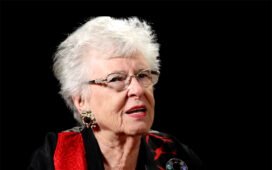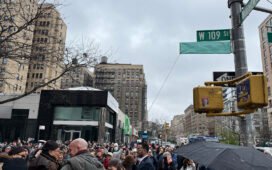(RNS) — It happened 30 years ago — the terrorist attack on the AMIA building in Buenos Aires.
When the terrorists drove their explosive-laden truck into the communal center of
Argentine Jewry, they succeeded in killing 85 people and injuring hundreds more.
The planning for these attacks was carried out by the Iranian government and Hezbollah.
It was the worst terrorist attack in the history of the Western Hemisphere — that
is, until Oklahoma City and, of course, the attacks on Sept. 11, 2001.

FILE – Firefighters and rescue workers search through the rubble of the Argentine Jewish Mutual Association, a community center known by its Spanish acronym AMIA, after a car bomb rocked the building, killing 85 people, in Buenos Aires, Argentina, July 18, 1994. (AP Photo/Alejandro Pagni, File)
Right after the attack on the AMIA building, I visited Buenos Aires on a rabbinic
mission of mercy to the bereaved Jews of that community, sponsored by New York
Federation. We engaged in impromptu pastoral counseling, reaching out to numerous Jews who had lost loved ones, especially kids and teenagers.
Together, our small group of rabbis stood in the rubble of the AMIA building.
There, one of my colleagues (who has since died) offered a eulogy for the victims.
“This is what happens when there is mental illness in the world. This is what happens when there is depravity in the world. What happened in this place is the triumph of psychological disease.”
Only my manners and my good breeding restrained me from grabbing his lapels and
shrieking in his ear:
“Forget psychological disease! Forget symptoms! This is not the DSM III (or IV or V) Diagnostic and Statistical Manual of Mental Disorders. This is not simply about getting a better therapist who will accept your health insurance. This is evil! Name it. Speak of it. Call it what it is.”
I will never forget what my colleague said to me in response at that moment. He turned to me and said, softly: “Don’t you think that’s being a little bit judgmental?”
I responded: “If you cannot stand in the rubble of a Jewish community center and
be judgmental, where and when else can you be judgmental?”
Somewhere and somehow, when it became time for us to name evil, we became tongue-tied. When, in the wake of 9/11, President George W. Bush pledged to rid the world of “evil doers,” we snickered.
Singer-songwriter John Martyn wrote a song with these lyrics: “I don’t want to know about evil. I only want to know about love.”
No. To not want to know about evil — to only want to know about love — is a moral luxury we cannot afford. It defines the problem. The children of the Enlightenment have no sense of what it means to be living in the time of the endarkenment.
The endarkenment.
I visited the “Gaza envelope” — the ruins of Kibbutz Nir Oz; the site of the Nova music festival; a women’s trauma center; a meeting with a woman who had been a hostage.
What was I thinking — that whole dark, hot, depressing and, yet, inspiring day?
This is evil. Pure, unadulterated evil.
Several years ago, Susan Neiman wrote: “Auschwitz … stands for all that is meant when we use the word evil today: absolute wrongdoing that leaves no room for account or expiation.”
I wonder: Will the mere mention of the date of Oct. 7 become another metaphor, another short-hand term, for radical evil in our time?
Next weekend, I will be making my annual trip to the Berkshires. As I regularly do, I will visit the grave of the Christian thinker Reinhold Niebuhr, whose work influenced the Rev. Martin Luther King Jr. and President Barak Obama. Niebuhr is buried in Stockbridge, in a cemetery on the other side of town from the early American revivalist theologian Jonathan Edwards. (I will leave it to my Protestant colleagues to comment on the theological geography of these two Christian luminaries being buried on opposite sides of one New England zip code.)
After a pastorate in Detroit, Niebuhr became professor of practical theology at Union Theological Seminary in New York. That erstwhile institution is located only a block or so from the Jewish Theological Seminary, which caused one Jewish scholar to quip that JTS’s motto could be “love your Niebuhr as yourself.” In fact, Niebuhr and Abraham Joshua
Heschel were very close friends, and Heschel delivered the eulogy at Niebuhr’s funeral.
In the 1950s, Niebuhr wrote that modern culture has been completely oblivious to the abiding mystery of evil in human life. The Hebrew Bible soberly understands that mystery. Its view of human life is far from optimistic. “Woe to those who call evil good, and good evil” (Isaiah 5:20). Even more pointed, the words of the ancient sages: “Those who are kind to the cruel will wind up being cruel to the kind” (Midrash, Kohelet Rabbah 7:16).
That is what I was thinking when I encountered the horror of Kibbutz Nir Oz, where 46 people died, including small children, and many hostages were taken.
To quote Peter Berger, in “A Rumor of Angels,” as he writes that the encounter with human evil is itself proof of transcendence and the presence of God:
(That) transcendent element manifests itself in two steps. First, our condemnation is absolute and certain. It does not permit modification or doubt … . In other words, we give the condemnation the status of a necessary and universal truth. … Second, the condemnation does not seem to exhaust its intrinsic intention in terms of this world alone. Deeds that cry out to heaven also cry out for hell. … No human punishment is ‘enough’ in the case of deeds as monstrous as these. These are deeds that demand not only condemnation, but damnation in the full religious meaning of the word.
Some things just cry out to the heavens for damnation.
The AMIA bombing was one of them.
There have been far too many others.















